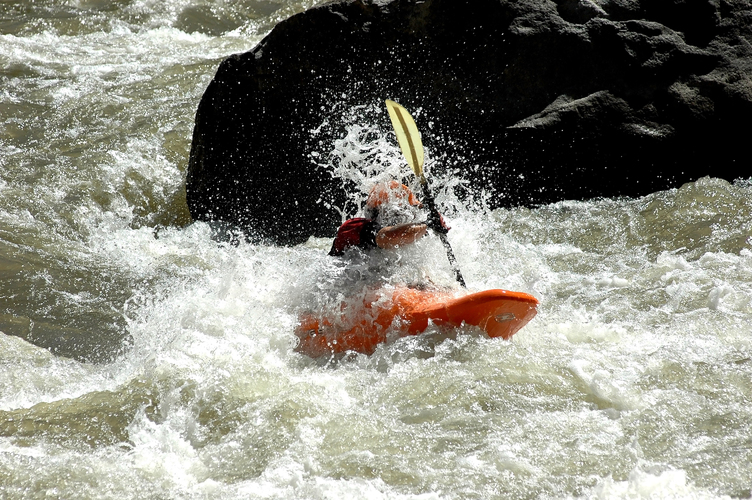The Local newsletter is your free, daily guide to life in Colorado. For locals, by locals.
Summer is in full swing, and the state’s rivers are primed for kayaking after all the recent rain. While paddlers might be thrilled to seize the opportunity to run a few stretches, with the waters high, it’s more important than ever to keep safety first.
Matt Mattes, head guide at Dvorak Expeditions, the state’s first (and longest) licensed outfitter, says that paddlers should check run descriptions, which often depend upon the flows, and the latest water levels, before launching—while high-flowing rivers are a kayaker’s dream, they can also be a nightmare if you’re not prepared.

“The rating scales have a lot to do with water levels (how big and pushy versus technical and rocky), and how accessible a run is (how far from help in an emergency),” explains Mattes. A properly fitting helmet and life jacket are essential, as well, and boaters should have a partner who is capable of helping in a swim scenario or other emergency. In addition, throw bags (specially designed bags of load-bearing rope) should be carried by everyone in the group, he says.
Most importantly, emphasizes Mattes, a boater needs to know his/her limits. “Walking a rapid or choosing to go to an easier section is an admirable and wise decision,” he says. Mattes strongly encourages all boaters to take a course in swift water rescue, which are offered by Dvorak and other groups around the state. While the class alone won’t make you an expert, it’s an important means of augmenting good judgement learned through extensive experience.
Once you’re prepared, here are a few runs to tackle this summer—no matter your level:
De Beque Canyon, Colorado River (Class I)
Suitable for canoes, duckies, and kayaks, this peaceful flatwater stretch on the Colorado River winds lazily past gravel islands, groves of cottonwoods, and tall sandstone cliffs. With a dozen access points along the route, you can create a run of any length. Beware of the multiple, low concrete dams in this stretch; they must be portaged.
Put-in: Newcastle (or various points downstream)
Take-out: Varies
Length: Short to 40+ miles
Deckers to Confluence, South Platte River (Class II–III)
Located below Cheesman Reservoir, this scenic stretch traverses the South Platte’s rolling granite terrain from the town of Deckers to the confluence with the North Fork. Easy access and several fun rapids at moderate water levels make this a great beginner to intermediate run.
Put-in: Deckers
Take-out: The confluence of the North and South forks (near South Platte)
Length: 15 miles (shorter runs are also possible)
Brown’s Canyon, Arkansas River (Class III)
This solid Class III run is classic and one of the most popular in Colorado. Try to run it weekdays and late in the afternoon to avoid some of the heavy commercial rafting traffic.
Put-in: Fisherman’s Bridge
Take-out: Hecla Junction
Length: 9 miles
Gunnison Gorge, Gunnison River (Class III–IV)
Although this run requires a mile-long hike to the river from a 4WD-accessible trailhead, the solitude, wildlife, and scenery are well worth the effort. This section is dam-controlled and usually runs May to September.
Put-in: Chukar Trail
Take-out: North Fork of the Gunnison
Length: 13 miles
Lower Clear Creek, Clear Creek (Class IV)
Just upstream of Golden, this close-to-home favorite requires a portage around a diversion dam.
Put-in: Rigor Mortis Bridge
Take-out: Golden
Length: 6 miles
The Numbers, Arkansas River (Class IV)
Some of Colorado’s best-known whitewater, this classic run north of Buena Vista has long, boulder-choked rapids and large holes at high flows. If you’re up for more, you can combine it with the Narrows-Frog Rock stretch (Class III–IV), which adds another 7 miles of foamy fun that ends at Buena Vista’s baseball fields.
Put-in: Numbers Put-in
Take-out: Railroad bridge
Length: 5 miles








